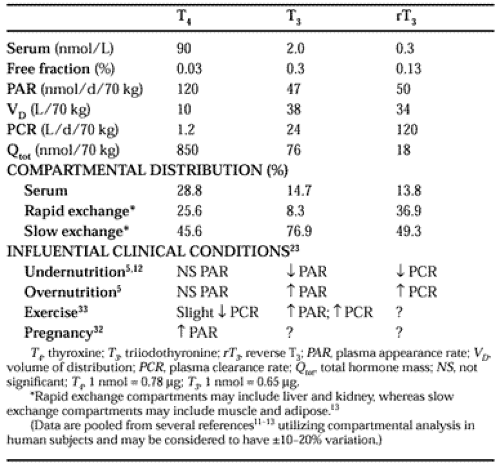THYROID HORMONE CIRCULATION AND TRANSPORT
Approximately 120 nmol of T4, 47 nmol of T3, and 50 nmol of reverse T3 (rT3) appear in the serum each day in a typical 70-kg person11,12 and 13 (Table 30-2). The balance between production and degradation is mediated by, among other things, nutrition, non-thyroidal illness, exercise, pregnancy, and medications. At steady-state conditions, this balance is reflected by serum values that represent only ˜29% of T4, 14% of T3, and 14% of rT3 total body hormone stores or pool (Qtot). Less than 1% of the total circulating amount of each hormone is free in the plasma (see Table 30-2). This extraordinary degree of binding to transport proteins has several important consequences: (a) The plasma contains a large capacity to store hormone, serving as a reservoir or a buffer against fluctuations in blood levels; (b) Little hormone is lost through the kidneys by glomerular filtration of free hormone; and (c) Changes in binding proteins affect the serum reservoir but do not affect the amount of free hormone, presumably not altering the physiologic actions of the hormone (see Table 30-1). Either the binding protein capacity, the free hormone concentration, or the binding protein concentration may be measured to clarify the changes in circulating T4 or T3 concentrations that accompany genetic or acquired aberrations in the binding proteins (also see Chap. 33 and ref. 13a).
Table 30-2 shows some of the similarities and differences between the major iodothyronines. T3 has 10% and rT3 has only 2% of Qtot compared with T4. Although ˜50% of T4 and rT3 circulates in the blood and other rapidly equilibrating tissues, such as liver and kidney, only ˜25% of T3 is found in these same kinetic compartments. Hormone stores are turned over at a rate of ˜10% per day for T4, 70% per day for T3, and 350% per day for rT3. Thus, with inhibited production of endogenous hormone (see Table 30-2) or increased appearance of exogenous hormone (e.g., increased dosage), the new steady-state conditions are reached within weeks for T4, within days for T3, and within hours for rT3.11,12 Compared with T3, T4 has a higher binding affinity (see Table 30-1) and slower plasma clearance rate (relative to the distribution volume [VD]), making T4 a stable circulating hormone reservoir and substrate for T3 formation. The rapid plasma clearance rate of T3, relative to its VD, is associated with more labile equilibration or disequilibration, reflecting shorter response times of circulating T3 to environmental and nutritional influences.
Stay updated, free articles. Join our Telegram channel

Full access? Get Clinical Tree







